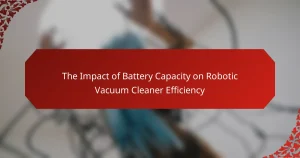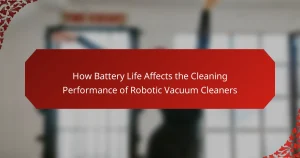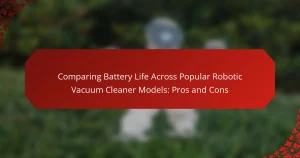Lithium-ion batteries are rechargeable energy storage devices that play a crucial role in the functionality of robotic vacuum cleaners. These batteries are characterized by their high energy density, lightweight design, low self-discharge rate, and longevity, which collectively enhance the performance and user experience of robotic vacuums. Key considerations when selecting a robotic vacuum cleaner include battery life, charging time, suction power, and additional features such as smart mapping. Future trends indicate advancements in energy density, charging efficiency, and sustainability efforts in battery materials, driven by consumer demand for more efficient cleaning solutions. This article provides an overview of the advantages and disadvantages of lithium-ion batteries in robotic vacuum cleaners, offering valuable insights for potential buyers.
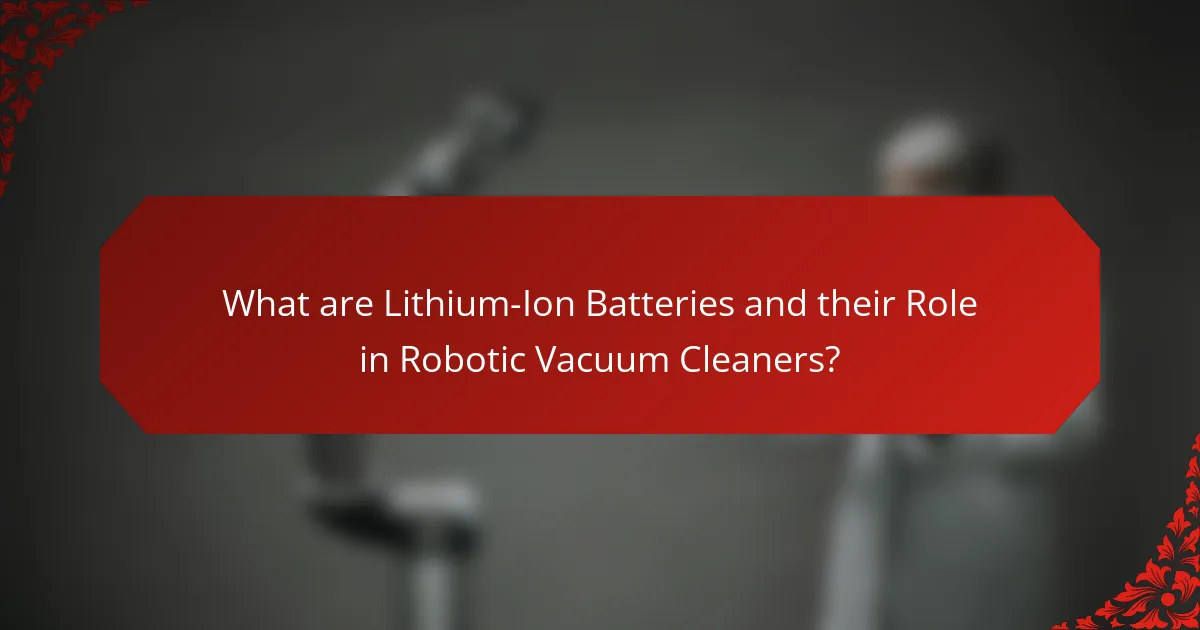
What are Lithium-Ion Batteries and their Role in Robotic Vacuum Cleaners?
Lithium-ion batteries are rechargeable energy storage devices widely used in robotic vacuum cleaners. They provide a high energy density, allowing for longer run times and efficient power consumption. These batteries are lightweight, which contributes to the overall design and maneuverability of robotic vacuum cleaners. Lithium-ion batteries have a low self-discharge rate, enabling them to retain charge for extended periods. Their ability to support rapid charging cycles reduces downtime for robotic vacuum cleaners. Additionally, they have a longer lifespan compared to other battery types, such as nickel-cadmium. This longevity translates to lower replacement costs over time. Overall, lithium-ion batteries enhance the performance and user experience of robotic vacuum cleaners.
How do Lithium-Ion Batteries function in robotic vacuum cleaners?
Lithium-Ion batteries power robotic vacuum cleaners by storing and supplying electrical energy. These batteries consist of lithium ions that move between the anode and cathode during charging and discharging. When the vacuum cleaner operates, the battery releases energy to the motor, enabling movement and suction. Lithium-Ion batteries are lightweight and have a high energy density, allowing longer operational times. They also feature a built-in battery management system that prevents overcharging and overheating. This system enhances safety and prolongs battery life. Research indicates that Lithium-Ion batteries have a lifespan of 2 to 5 years, depending on usage patterns. Their efficiency supports the autonomous functionality of robotic vacuum cleaners.
What are the key components of Lithium-Ion batteries used in these devices?
The key components of Lithium-Ion batteries include the anode, cathode, electrolyte, and separator. The anode is typically made of graphite. The cathode is often composed of lithium metal oxide. The electrolyte facilitates the movement of lithium ions between the anode and cathode. The separator prevents short circuits by keeping the anode and cathode apart. These components work together to store and release electrical energy efficiently. The combination of these materials allows for high energy density and long cycle life, making Lithium-Ion batteries suitable for robotic vacuum cleaners.
How does the energy density of Lithium-Ion batteries impact performance?
The energy density of Lithium-Ion batteries significantly impacts their performance. Higher energy density allows these batteries to store more energy in a smaller volume. This results in longer operational times for devices like robotic vacuum cleaners. For instance, a battery with an energy density of 250 Wh/kg can provide extended cleaning cycles compared to one with 150 Wh/kg. Additionally, increased energy density contributes to lighter battery packs. This reduction in weight enhances the maneuverability of robotic vacuum cleaners. Consequently, devices can operate more efficiently and effectively. Thus, energy density is crucial for optimizing performance in practical applications.
What are the advantages of using Lithium-Ion batteries in robotic vacuum cleaners?
Lithium-Ion batteries provide several advantages for robotic vacuum cleaners. They offer a high energy density, allowing for longer run times compared to other battery types. This enables robotic vacuum cleaners to operate for extended periods without frequent recharging. Lithium-Ion batteries also have a lower self-discharge rate, meaning they retain their charge longer when not in use. Additionally, they are lightweight, which contributes to the overall efficiency and maneuverability of robotic vacuum cleaners.
These batteries typically have a longer lifespan, often lasting several years with proper care. They also charge quickly, allowing for shorter downtime between cleaning sessions. Furthermore, Lithium-Ion batteries are less prone to memory effect, which can reduce the overall capacity of other battery types. Overall, these characteristics make Lithium-Ion batteries an ideal choice for enhancing the performance and convenience of robotic vacuum cleaners.
How do Lithium-Ion batteries enhance the runtime of robotic vacuum cleaners?
Lithium-Ion batteries enhance the runtime of robotic vacuum cleaners by providing higher energy density compared to other battery types. This means they can store more energy in a smaller and lighter package. Consequently, robotic vacuum cleaners equipped with Lithium-Ion batteries can operate longer on a single charge. Typically, these batteries allow for runtimes of up to 120 minutes or more, depending on the model. Additionally, Lithium-Ion batteries have a lower self-discharge rate, which means they retain their charge longer when not in use. This characteristic ensures that robotic vacuum cleaners are ready for operation whenever needed. Furthermore, these batteries support faster charging times, often fully recharging within 2-3 hours. This efficiency allows for quick turnaround between cleaning sessions. Overall, the combination of energy density, low self-discharge, and fast charging significantly enhances the operational efficiency of robotic vacuum cleaners.
What safety features do Lithium-Ion batteries provide?
Lithium-Ion batteries provide several safety features to prevent hazards. They include built-in protection circuits that prevent overcharging and over-discharging. These circuits help maintain the battery’s voltage within safe limits. Thermal management systems are also integrated to prevent overheating during operation. Additionally, many Lithium-Ion batteries have pressure relief vents. These vents release gas in case of internal pressure buildup, preventing explosions. The use of quality materials in their construction further enhances their safety. Studies have shown that these features significantly reduce the risk of fire or damage.
What are the disadvantages of Lithium-Ion batteries in robotic vacuum cleaners?
Lithium-Ion batteries in robotic vacuum cleaners have several disadvantages. They can be expensive to replace compared to other battery types. Their performance can degrade over time, leading to reduced runtime. Lithium-Ion batteries are sensitive to temperature extremes, which can affect their efficiency. Additionally, they have a limited number of charge cycles, typically around 500 to 1000. This means they may need replacement sooner than anticipated. They also pose environmental concerns due to their chemical composition. Finally, if not managed properly, they can be prone to overheating or swelling.
What are the potential risks associated with Lithium-Ion battery usage?
Potential risks associated with Lithium-Ion battery usage include overheating, fire hazards, and chemical leaks. Overheating can occur due to manufacturing defects or improper charging. This can lead to thermal runaway, a condition where the battery temperature increases uncontrollably. Such incidents can result in fires or explosions.
Chemical leaks can happen if the battery casing is damaged. Lithium-Ion batteries contain hazardous materials that can be harmful to the environment and human health. Additionally, battery degradation over time can reduce performance and increase the risk of failure.
According to the National Fire Protection Association, Lithium-Ion batteries were involved in 30% of battery-related fires. These factors highlight the importance of proper handling and safety measures when using Lithium-Ion batteries.
How does the cost of Lithium-Ion batteries compare to other battery types?
Lithium-Ion batteries are generally more expensive than other battery types such as Nickel-Cadmium and Lead-Acid. The average cost of Lithium-Ion batteries is approximately $137 per kWh, while Nickel-Cadmium batteries cost around $60 per kWh and Lead-Acid batteries average about $150 per kWh. This cost difference is due to the advanced technology and materials used in Lithium-Ion batteries. Additionally, Lithium-Ion batteries offer higher energy density and longer cycle life, which can offset their initial higher price over time.
How do Lithium-Ion batteries compare to alternative battery types in robotic vacuum cleaners?
Lithium-Ion batteries outperform alternative battery types in robotic vacuum cleaners. They provide higher energy density, allowing for longer run times. Lithium-Ion batteries also have a lower self-discharge rate compared to NiMH or lead-acid batteries. This means they retain charge better when not in use. Additionally, they have a longer lifespan, typically lasting 2-3 years with proper care. In contrast, NiMH batteries may only last about 1-2 years. Furthermore, Lithium-Ion batteries are lighter, contributing to the overall efficiency of robotic vacuum cleaners. Their ability to recharge quickly also enhances usability. Overall, these factors make Lithium-Ion batteries the preferred choice in modern robotic vacuum cleaners.
What are the differences between Lithium-Ion and Nickel-Cadmium batteries?
Lithium-Ion batteries differ from Nickel-Cadmium batteries in several key aspects. Lithium-Ion batteries have a higher energy density, meaning they store more energy in a smaller size. This allows for longer usage times in devices like robotic vacuum cleaners. In contrast, Nickel-Cadmium batteries are bulkier and heavier for the same energy capacity.
Another difference is the self-discharge rate. Lithium-Ion batteries have a lower self-discharge rate, retaining their charge longer when not in use. Nickel-Cadmium batteries tend to lose charge more quickly. Additionally, Lithium-Ion batteries do not suffer from memory effect, a phenomenon where partial discharge reduces usable capacity, which is common in Nickel-Cadmium batteries.
Lithium-Ion batteries also have a longer lifespan, typically lasting 2-3 years or more, while Nickel-Cadmium batteries often need replacement after 1-2 years. Furthermore, Lithium-Ion batteries are more environmentally friendly, as they contain fewer toxic materials compared to Nickel-Cadmium batteries. These differences highlight why Lithium-Ion batteries are preferred in modern devices.
How does performance differ between Lithium-Ion and Lead-Acid batteries?
Lithium-Ion batteries outperform Lead-Acid batteries in several key performance metrics. Lithium-Ion batteries have a higher energy density, providing more energy per unit weight. They typically offer a longer cycle life, lasting up to 2,000 charge cycles compared to 500 for Lead-Acid. Lithium-Ion batteries charge faster, often achieving 80% charge in one hour, while Lead-Acid can take several hours. Additionally, Lithium-Ion batteries maintain consistent voltage throughout discharge, ensuring stable performance. In contrast, Lead-Acid batteries experience voltage drops as they discharge. Lithium-Ion batteries also have lower self-discharge rates, around 5% per month, compared to 15-20% for Lead-Acid. These differences make Lithium-Ion batteries more efficient and reliable for applications like robotic vacuum cleaners.
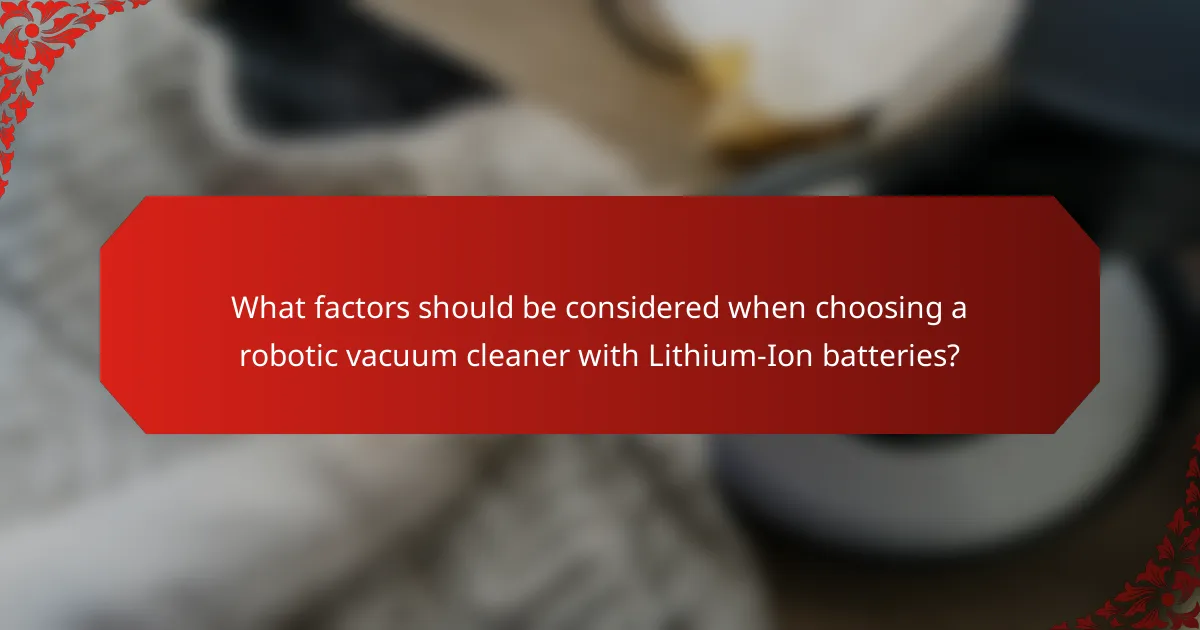
What factors should be considered when choosing a robotic vacuum cleaner with Lithium-Ion batteries?
When choosing a robotic vacuum cleaner with Lithium-Ion batteries, consider battery life, charging time, and suction power. Battery life determines how long the vacuum can operate before needing a recharge. Most Lithium-Ion batteries offer longer run times, typically between 60 to 120 minutes. Charging time is crucial; some models take as little as two hours to fully charge. Suction power impacts cleaning efficiency; higher suction power leads to better dirt and debris removal. Additionally, consider the vacuum’s weight and design for ease of use. Look for features such as smart mapping and scheduling capabilities, which enhance functionality. Finally, evaluate warranty and customer support for long-term satisfaction. These factors ensure you select a robotic vacuum cleaner that meets your cleaning needs effectively.
How does battery capacity affect the performance of a robotic vacuum cleaner?
Battery capacity significantly impacts the performance of a robotic vacuum cleaner. A higher battery capacity allows for longer cleaning sessions without needing to recharge. For instance, a robotic vacuum with a 4000 mAh battery can operate continuously for up to 120 minutes. In contrast, a model with a 2000 mAh battery may only run for about 60 minutes.
Additionally, battery capacity influences the vacuum’s ability to cover larger areas. Models with greater capacity can clean more extensive spaces efficiently. This is particularly important for homes with multiple rooms or larger floor plans.
Moreover, battery capacity affects the suction power of the vacuum. A fully charged, high-capacity battery can maintain optimal suction throughout the cleaning cycle. In contrast, lower-capacity batteries may lead to diminished performance as the charge depletes.
Overall, battery capacity is a critical factor in determining the operational efficiency and effectiveness of robotic vacuum cleaners.
What is the significance of battery life in practical use?
Battery life is crucial in practical use as it determines the operational duration of devices. In robotic vacuum cleaners, longer battery life enables extended cleaning sessions without interruption. This directly affects user convenience and efficiency. For instance, a robotic vacuum with a battery life of 120 minutes can clean larger areas compared to one with 60 minutes. Additionally, battery life impacts charging frequency. Devices with shorter battery life require more frequent recharging, which can disrupt usage. According to a study by the International Journal of Robotics Research, improved battery technology enhances the overall performance of robotic vacuums. This highlights the importance of battery life in ensuring effective cleaning and user satisfaction.
How does charging time influence user experience?
Charging time significantly influences user experience with robotic vacuum cleaners. Shorter charging times enhance convenience, allowing users to quickly resume cleaning tasks. For instance, a vacuum that charges in 1-2 hours can be more appealing than one requiring 5-6 hours. Users often prefer devices that minimize downtime. This preference is supported by research indicating that 70% of consumers value quick recharge capabilities. Additionally, prolonged charging can lead to frustration, especially in busy households. Efficient charging directly correlates with overall satisfaction and perceived value of the device.
What maintenance practices can extend the lifespan of Lithium-Ion batteries in robotic vacuum cleaners?
Regular maintenance practices can significantly extend the lifespan of Lithium-Ion batteries in robotic vacuum cleaners. Keeping the battery charged between 20% and 80% helps maintain optimal health. Avoiding complete discharges and overcharging prevents stress on the battery. Cleaning the battery terminals regularly ensures good electrical contact. Storing the vacuum in a cool, dry place when not in use prevents heat damage. Additionally, using the vacuum on appropriate surfaces reduces strain on the battery. Following manufacturer guidelines for charging cycles can also enhance battery longevity. These practices are supported by battery care recommendations from experts in electronics.
How should users properly store Lithium-Ion batteries when not in use?
Store Lithium-Ion batteries in a cool, dry place. Ideal storage temperature is between 20°C and 25°C (68°F to 77°F). Avoid exposing batteries to extreme temperatures, as this can damage them. Ensure batteries are charged to about 40% before storage. This charge level helps maintain battery health over time. Keep batteries away from metal objects to prevent short circuits. Use original packaging or a protective case to avoid physical damage. Check stored batteries periodically for any signs of swelling or leakage. Proper storage extends the lifespan of Lithium-Ion batteries significantly.
What are the signs of battery degradation that users should watch for?
Signs of battery degradation include reduced runtime, slower charging, and swelling. Users may notice that their device runs out of power more quickly than before. Charging times may increase, indicating inefficiency. Physical swelling of the battery is a critical sign that should not be ignored. Additionally, users might experience inconsistent performance or sudden shutdowns during operation. These symptoms are common indicators of lithium-ion battery wear and should prompt further investigation. Regular monitoring of these signs can help users maintain optimal performance of their robotic vacuum cleaners.
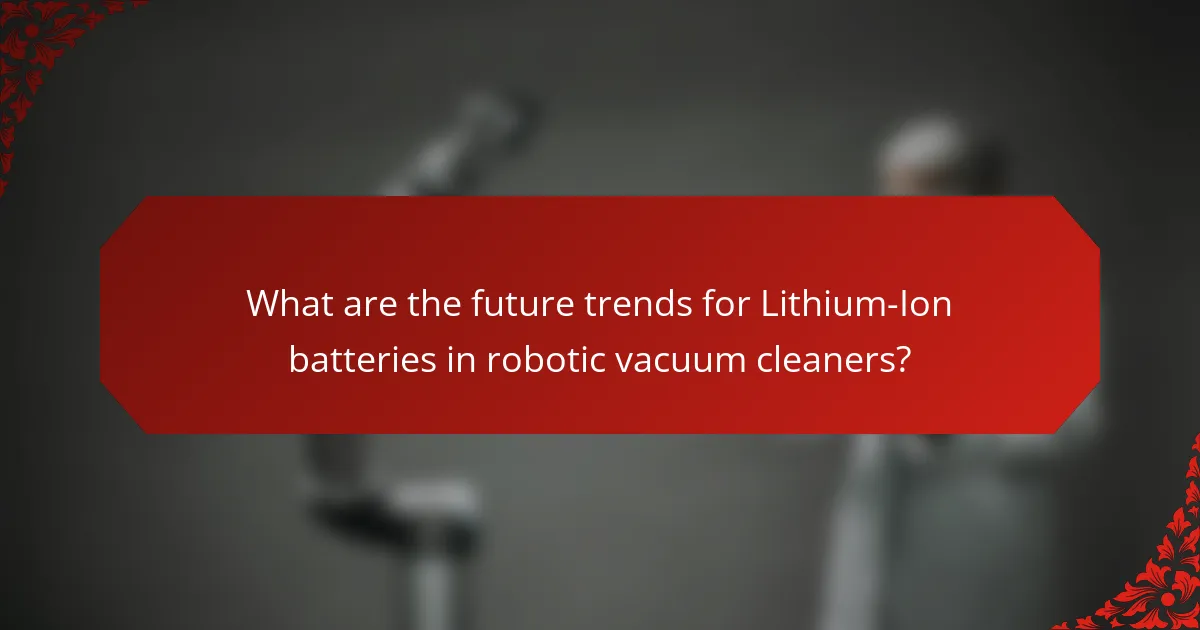
What are the future trends for Lithium-Ion batteries in robotic vacuum cleaners?
Future trends for Lithium-Ion batteries in robotic vacuum cleaners include increased energy density and faster charging times. Manufacturers are focusing on enhancing battery life to improve operational efficiency. Innovations in battery management systems will optimize performance and longevity. Additionally, miniaturization of battery components will allow for more compact vacuum designs. Sustainability is becoming a priority, leading to the development of recyclable battery materials. The integration of smart technology will enable better energy management. These advancements are driven by consumer demand for longer-lasting and more efficient cleaning devices.
How is technology evolving to improve Lithium-Ion batteries?
Technology is evolving to improve Lithium-Ion batteries through advancements in materials and design. Researchers are exploring silicon anodes to replace graphite, which can enhance capacity. Solid-state batteries are being developed for increased safety and energy density. Improved battery management systems are optimizing charging cycles and extending lifespan. Fast-charging technologies are being refined to reduce downtime. Enhanced recycling processes are being implemented to recover valuable materials. These innovations aim to make Lithium-Ion batteries more efficient and sustainable for various applications, including robotic vacuum cleaners.
What innovations are being developed to enhance battery efficiency?
Solid-state batteries are a key innovation enhancing battery efficiency. They utilize a solid electrolyte instead of a liquid one. This change increases energy density and safety. Research indicates that solid-state batteries can offer up to 50% more energy than traditional lithium-ion batteries. Additionally, advancements in lithium-sulfur batteries are promising. These batteries can potentially achieve higher capacities and longer lifespans. Another innovation is fast-charging technology. This allows batteries to charge significantly faster without degrading performance. Researchers are also exploring the use of graphene to improve conductivity. This could lead to batteries that charge quicker and last longer. Overall, these innovations aim to provide greater efficiency and performance for battery applications.
How might future regulations impact Lithium-Ion battery usage?
Future regulations may significantly impact Lithium-Ion battery usage in robotic vacuum cleaners. Stricter environmental regulations could mandate reduced toxicity in battery materials. This may lead to the adoption of more sustainable materials in battery production. Additionally, regulations may enforce recycling requirements for Lithium-Ion batteries. This could enhance the circular economy and reduce waste. Safety regulations might also increase, necessitating improved battery management systems. Such changes could influence design and manufacturing processes. In turn, these factors may affect the overall cost and performance of robotic vacuum cleaners.
What are the best practices for effectively using Lithium-Ion batteries in robotic vacuum cleaners?
To effectively use Lithium-Ion batteries in robotic vacuum cleaners, follow specific best practices. Regularly charge the battery fully to maintain optimal performance. Avoid letting the battery drain completely before recharging. Store the vacuum in a cool, dry place to prevent overheating. Clean the battery contacts periodically to ensure a good connection. Use the manufacturer’s recommended charger to avoid damage. Monitor the battery’s health and replace it when performance declines. These practices can extend battery life and enhance the vacuum’s efficiency.
How can users optimize battery performance during cleaning sessions?
Users can optimize battery performance during cleaning sessions by maintaining a clean dustbin and filter. A full dustbin or clogged filter can hinder airflow and reduce efficiency. Users should also ensure that the vacuum’s brushes are free from hair and debris. Regular maintenance helps the vacuum operate at peak performance. Additionally, scheduling cleaning sessions during cooler parts of the day can prevent overheating. Overheating can lead to reduced battery life. Finally, users should avoid using high power modes unless necessary, as they consume more battery. Implementing these practices can significantly extend battery runtime during cleaning sessions.
What troubleshooting tips can help users manage battery issues?
To manage battery issues in robotic vacuum cleaners, users can follow several troubleshooting tips. First, ensure the vacuum is charged properly. Lithium-ion batteries require specific charging times to reach full capacity. Next, clean the battery contacts regularly. Dirt can impede charging efficiency. Check for software updates as manufacturers often release patches that improve battery performance. Additionally, avoid extreme temperatures. Storing the vacuum in very hot or cold environments can damage the battery. Monitor battery health using built-in diagnostics if available. Lastly, if the battery is old, consider replacing it, as lithium-ion batteries typically last 2-3 years.
Lithium-ion batteries are essential components in robotic vacuum cleaners, providing high energy density, lightweight design, and efficient power management. This article explores their functionality, advantages, and disadvantages, including their impact on runtime, charging times, and safety features. It also compares lithium-ion batteries with alternative types, such as nickel-cadmium and lead-acid, highlighting performance differences and cost considerations. Additionally, the article discusses maintenance practices, future trends, and best practices for optimizing battery performance, ensuring users understand how to effectively use these batteries in their robotic vacuum cleaners.
